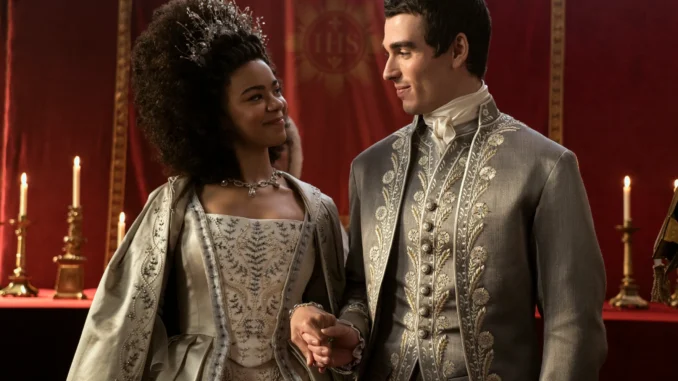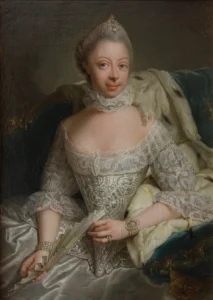
Shonda Rhimes’s new show imagines an interracial romance that remakes Regency England. That certainly didn’t happen.
The first time I heard someone call Charlotte, Queen Consort to King George III, the “first Black queen of England,” I thought they were taking the piss. But even though the evidence for Charlotte’s Black heritage is weak, many do truly believe it. And now, millions more will believe it too.
The premiere of Queen Charlotte: A Bridgerton Story, a Shondaland production based on the romance novels by Julia Quinn, tries to cement the public image of the monarch as an undeniably Black woman. The prequel series gives Queen Charlotte (India Amarteifio in youth and Golda Rosheuvel in her later years) the spotlight. Here, she is a Black teenager whose interracial marriage to the mentally ill King George III (Corey Mylchreest in youth; James Fleet as the older version) led to an event called “the Great Experiment.” In Queen Charlotte and the original Bridgerton series, the Great Experiment refers to Britain’s (clearly fictional) decision to fully integrate Black people and other people of color into their society, including the noble class. In Queen Charlotte, the stakes of the Great Experiment are most vocally echoed by Lady Danbury (Adjoa Andoh in her later years and Arsema Thomas as a young woman), who is revealed to be African royalty with wealth that exceeds that of most of the British nobles but has to fight to be accepted among British nobility.

Most people know this didn’t happen.It’s common sense that Black people were not accepted into all levels of British society in the 18th and 19th centuries. And, if Meghan Markle’s experiences as part of the royal family are any indicated, they’re not accepted among British nobility now. Although people widely understand this element of the story is fantastical, many do consider the real Queen Charlotte to be Black. And Netflix and Shondaland are fanning that flame. Netflix even threw a royalty-themed event with Historically Black Colleges and Universities (HBCUs) to celebrate the premiere. The messages Queen Charlotte sends about the politics of wealth, interracial relationships, representational politics, and empire are dangerous. At the core of its danger is the choice to double down on the likely false idea that Queen Charlotte was Black.
The weak evidence for Queen Charlotte’s Blackness
Although Charlotte and George did not have an interracial relationship that changed the course of history, there was public debate about Charlotte’s appearance. Some accounts and portraits of her suggest that she had fair skin and “European” features, others show her having slightly darker skin and “African” features. She was also often called ugly and plain. In A Tale of Two Cities, referring to George and Charlotte, Charles Dickens wrote: “There was a king with a large jaw, and a queen with a plain face, on the throne of England.” Her physician described her as “small and crooked, with a true mulatto face.” Sir Walter Scott wrote that she was “ill-colored.” A prime minister once said: “Her nose is too wide and her lips are too thick.”
The show reconstructs the vague reports of her appearance into Charlotte experiencing both racism and ties of kinship with other Black people; King George III’s mother Princess Augusta (Michelle Fairley) complains about Charlotte’s skin being “very brown” and a minister meekly replies, “I told you she had Moor blood.” Her brother admits that no one “looked like” they had ever married into the British royal family (even though Charlotte and George in real life were related), wedding guests murmured in shock at Charlotte’s jewel-encrusted Afro, and Lady Danbury had a wide-eyed look of joy upon seeing the new Queen is “on our side.”
Even though Queen Charlotte’s contemporaries made it clear that they thought her face didn’t meet their beauty standards, there are almost no records of anyone explicitly saying that Charlotte, born into the royal family of the northern German duchy of Mecklenburg-Strelitz, had Black parents, Black siblings, Black cousins, or Black ancestors on either side. In 1997, historian Mario de Valdes y Cocom claimed his research showed she was descended from the “illegitimate son of King Alfonso I of Portugal and his Moorish mistress [Madragana].”
However, King Alphonso I was born in 1109 or 1111, and Queen Charlotte was born in 1744. That’s more than 600 years of distance between Queen Charlotte and her rumored African ancestor Madragana — who cannot conclusively be proven to be Black or related to Queen Charlotte , as art historian Amanda Matta explains on her podcast, Art of History. Some amount of inbreeding might account for these features to endure for a few generations, but not enough to be significant.
